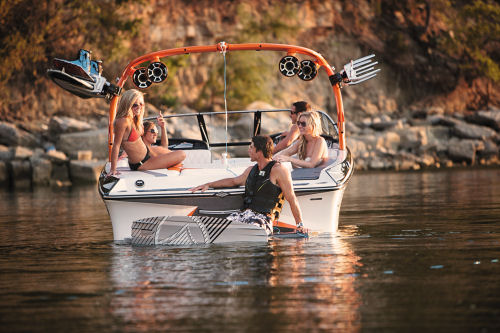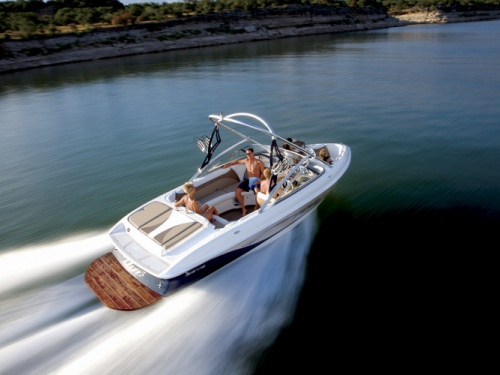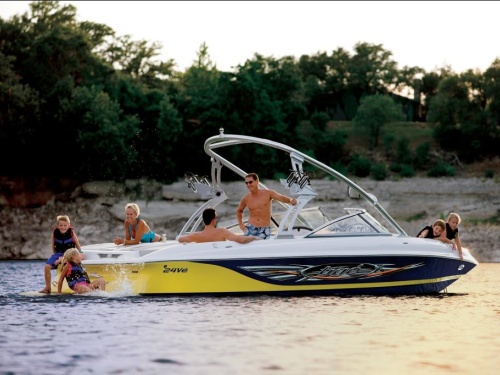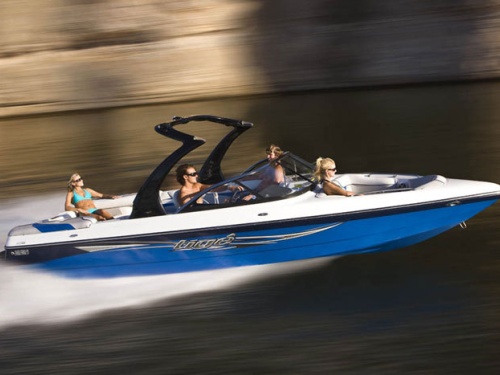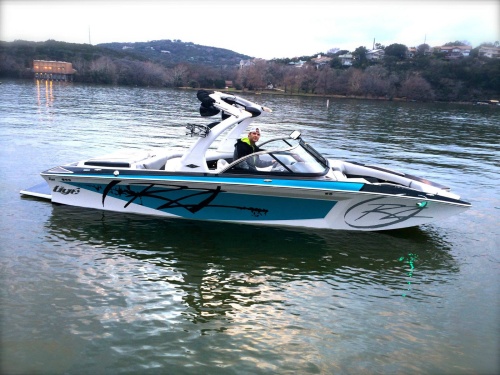Access More Boat Tests
Already have an account? Login
Tigé RZ4 (2011-)
1 x 343-hp PCM EX343 5.7L MPI
Brief Summary
Tigé has trying to push the envelope with style and performance with their line of wakeboard boats. But after getting onboard and driving it firsthand, we found that it's not only a serious watersports platform, but a very capable cruiser that the whole family can enjoy. Of course when it's time to get extreme, the RZ4 can deliver on that as well.
Key Features
- Patented ConvexV Hull & TAPS2 Technology
- Hand-laid multi-directional fiberglass hull
- Coremat-enhanced lamination throughout
- LifePlus Core all-composite stringer matrix system
- All-composite floor with 3/4” fiberglass-reinforced core
- Aluminum ski pylon
- Stainless steel appearance package
- Lexan walkthrough windscreen
- Triple hull tracking fins
- Heavy-duty all-brass underwater gear
- Stainless steel capped curved glass windshield
- Bow and stern lighting
- Bilge blower ventilation system
- Heavy-duty marine-grade 12v battery
- E Controls electronic technology
- Tigé SpeedSet cruise control
- TigéTouch Medallion can-bus digital instrumentation
Test Results
| RPM | MPH | Knots | GPH | MPG | NMPG | STAT. MILE | NM | dBa |
|---|---|---|---|---|---|---|---|---|
| 650 | 4.2 | 3.6 | 0.9 | 4.61 | 4.01 | 199 | 173 | 66 |
| 1000 | 5.4 | 4.7 | 1.5 | 3.69 | 3.21 | 159 | 139 | 72 |
| 1500 | 8 | 7 | 2.4 | 3.33 | 2.9 | 144 | 125 | 75 |
| 2000 | 9.3 | 8 | 3.8 | 2.43 | 2.12 | 105 | 91 | 84 |
| 2500 | 16.1 | 14 | 5.7 | 2.82 | 2.45 | 122 | 106 | 86 |
| 3000 | 25.3 | 22 | 8.2 | 3.09 | 2.68 | 133 | 116 | 87 |
| 3500 | 29.5 | 25.6 | 10.1 | 2.92 | 2.54 | 126 | 110 | 87 |
| 4000 | 35 | 30.4 | 12.5 | 2.8 | 2.43 | 121 | 105 | 85 |
| 4500 | 38.3 | 33.3 | 17.4 | 2.2 | 1.91 | 95 | 83 | 89 |
| 5000 | 41.1 | 35.7 | 20.8 | 1.98 | 1.72 | 85 | 74 | 93 |
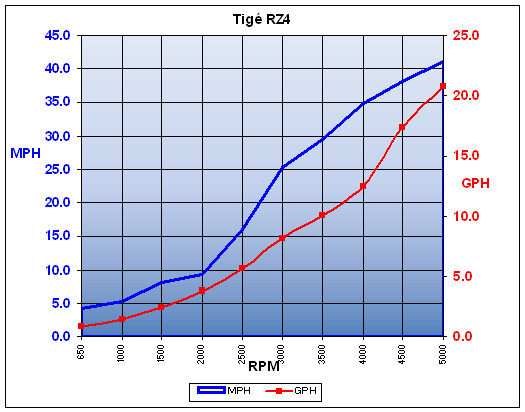
Specifications
| Length Overall | 24' 0'' / 7.32 m |
|---|---|
| Beam |
8' 6'' 2.59 m |
| Dry Weight |
4,485 lbs. 2,034 kg. |
| Draft | N/A |
| Deadrise/Transom | N/A |
| Max Headroom | open |
| Bridge Clearance | N/A |
| Fuel Capacity |
48 gal. 181.6 L |
| Water Capacity | none |
Acceleration Times & Conditions
| Time to Plane | 2.6 sec. |
|---|---|
| 0 to 30 | 8.5 sec. |
| Ratio | 1.46 : 1 |
| Props | 13.5 x 16 x 4 |
| Load | 2 persons, 1/2 fuel, no water, minimal gear |
| Climate | 90 deg.; 36% humidity; wind: 10-15 mph; seas; light chop |
Engine Options
| Tested Engine |
1 x 343-hp PCM EX343 5.7L MPI |
|---|---|
| Std. Power |
1 x 343-hp PCM EX343 5.7L MPI |
| Opt. Power |
1 x 409-hp PCM 6.0 L ZR MPI 1 x 450-hp PCM 6.0 L 1 x 550-hp PCM 6.0 L Supercharged |
Warranty
| Hull Warranty Extended | Lifeplus Lifetime |
|---|
Captain's Report
Captain's Report by Capt. Steve

It’s sure hard to look at any boat in the Tigé lineup and not see just how cool these boats really are. But looks are only half the battle plan for marketing a boat. If it’s all show and no go then the lineup falls flat. So I needed to get on the water with these boats and see what’s up. And that’s exactly what I did. Here’s what I found---
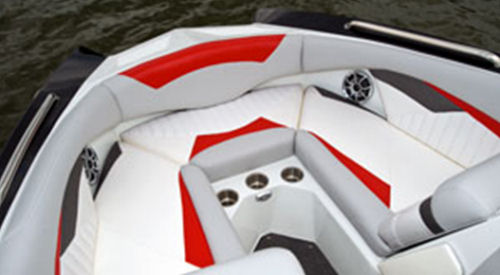
Handling
Taken as a regular general watersports boat, as opposed to a wakeboat, the RZ4 performed nicely. Turns were crisp and well defined with just a little slide to counter the forces that can turn uncontrollable in a hard turn. At any speed, the boat was fully maneuverable and offered nothing out of the ordinary that may surprise the unwary.
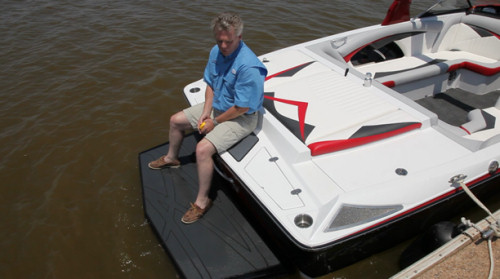
Now you have to keep in mind that the Tigé RZ4 is an inboard boat, so handling will be a little different than a sterndrive. Some of these differences are good, and some not so much, if you listen to public opinion. The good differences were mostly notable in the high speed turns. There was no prop cavitation at any speed, so you don’t have to worry about trim in a hard turn. I was throwing the boat into very hard turns and was surprised that the boat didn’t come flying off from the sideways forces, but she hung fast and showed no signs of slipping out…ever. That adhesion to the water is thanks to the three stabilizing fins protruding down from her keel and, of course, she's is an inboard.

Another characteristic of this inboard drive in the Tigé RZ4 is that it’s connected to a V-drive transmission. So unlike other wakeboard boats on the market, there’s no big ol’ engine box in the middle of the cockpit. This engine is well aft leaving plenty of play room in the cockpit.
And finally on the plus side is the safety factor. The prop is under the boat, not at the stern.
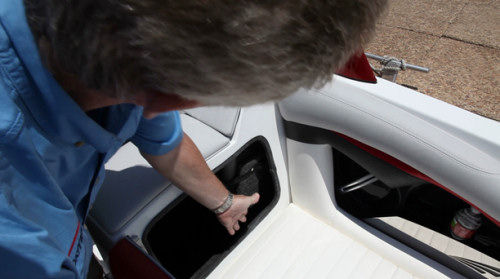
The downside to any single-engine inboard installation is in docking, and this boat was no exception. The boat backs to starboard. So it is a matter of getting the hang of it and you will with some experience -- people have been docking them quite nicely for 90 years or so. We'll even tell you the trick...
Inboard Docking Made Easy
How do you do that? Easily. Make all your dockings to the starboard side. Approach the dock slightly off, and then when you back down, the stern will get pulled over. To keep the stern from hitting the dock first, be turned hard to starboard, and just a touch of forward will push the stern away enough so that the boat comes up against the dock flush with the whole side of the boat, rather than one section hitting first.
With a few minutes practice, and some forward and reverse, you can get the hang of it and you’ll be an instant pro. Be gentle, you won’t feel the transmission “clunk” as it slips into gear. It’s silky smooth. Tigé also deals with it by making the boarding walkthrough on the starboard side. It's also at roughly the same level as the dock so loading gear is much easier.

The Wake Maker
So the real deal is in the RZ4’s wake handling. Tigé approaches the game a little differently. Where most, if not all, other wakeboard boat hulls have a straight line running towards the stern, and then a hook down to give the stern the “dig in," Tigé actually makes their hull curve up at the stern -- it's called Convex V. Then, the TAPS2 comes into play.
TAPS stands for Tigé Adjustable Performance System, and it’s basically a wide plate at the stern that you can adjust like a trim tab. Only unlike trim tabs, this is in the center of the hull at the bottom of the transom. You can run with it up, for a flat wake, or run with it down for a fat wake.
I did find it necessary to use the TAPS plate when running at high speed. There tended to be a bit of bow oscillation and by bringing the TAPS plate down, the bow would be held to the water better.
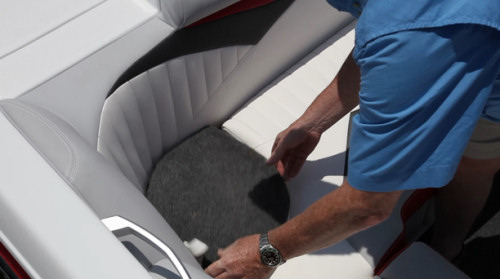
Let 'Em Eat Wake!
Now, with the ballast tanks full (four of them, two in the stern, two in the bow) the difference in wake was significant. Moving the TAPS 2 plane up and down resulted in a large change in the wake, from a sporty “jumping for the fun of catching a little air” size wake, to a “jumping into the air and flying from one side of the boat to the other” size of wake.
From a performance and handling standpoint, with the TAPS plane down the boat is converted into a depressing, bow high, fuel burner, but then again, when wakeboarding, the driver’s aspect is of little concern… it’s all about the wake!! And in the Tigé RZ4, I had complete control of the wake and could make it do whatever I wanted.
It took a little time to get it where I wanted it to be, what with filling and draining ballast bags (about a 15 minute one way trip), but I could definitely get it there and anyone at the end of the towline would be pleased with the customized results. With the TAPS 2 plate you can fine tune the wake, making it bigger or smaller, putting in more curl or less, all with the one hand control.
So if TAPS 2 is all that great, why doesn’t everybody do it? Because they can’t. Tigé patented it. Smart move on Tigé’s part.
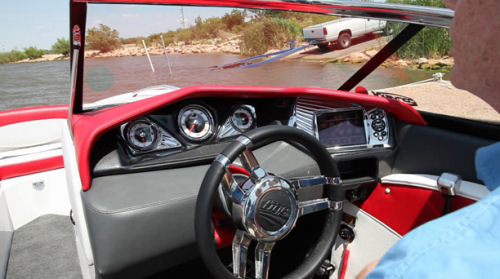
Tigé Touch
But once you get it to where you want it, the question is… can you get it there again? What if you are towing a guy and finally arrive at that sweet spot of performance. Will you be able to arrive at it again for him, and what’s more… can you do it for all the other guys (and gals) you’re taking out on your boat?
The answer is a resounding yes. And you do it with Tigé Touch. This proprietary device allows you to utilize a touch screen to input very specific parameters and save them as profiles, and even name the profiles. So when Bob decides that you’ve reached a perfect wake for him, then you save that set of parameters as a profile named “Bob” and then, at the touch of a button, Bob’s a happy camper every time. If his skills improve and he wants to tweak things a bit, just edit the profile and you’re done.
Tigé Touch is able to control not only the boat’s speed, but the levels of individual ballast tanks and the level of the TAPS 2 running plate. All with touch screen capability. I think this is a huge feature.
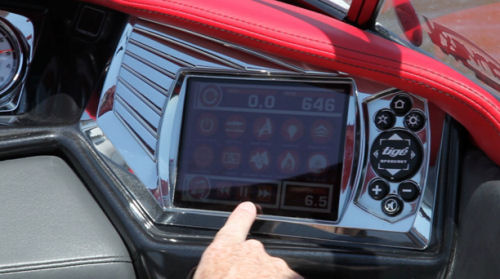
But it gets better. Tigé Touch also gives you control of the boat's lights, all switches for pumps and blowers, as well as the tunes. You can even change the input for the tunes from AM, FM, MP3, Sirius, and Aux inputs. (There’s more to Tigé Touch, but we get into it much deeper in its own video demonstration. Check it out…)
Performance and Specifications
The Tigé RZ4 has a LOA of 24’ (7.32 m), and a beam of 8' 6" (2.6 m). Her empty weight is 4,485 lbs. (2,034 kgs) and she carries 48 gallons (181.7 L) of fuel. We tested the Tigé RZ4 on a hot Texas day with 10-15 mph winds a light chop and our test boat was powered with a PCM EX343.

This is a 5.7L MPI engine, and you have to give high marks to PCM for calling it as it is. Their EX343 is 343-hp. No confusing marketing hype here. Her top speed was found to be 41.1 mph and her best cruise came at 3000 rpms and 25.3 mph. At that speed, the RZ4 was burning only 8.2 gallons per hour, and with her tanks topped off, she’ll have a range, at that speed, of 133 miles with a 10% reserve. Now that’s a lot of wakeboarding.
Overall, I was very impressed with the Tigé RZ4. While not intending to cross the marketing stream between wakeboard boat and cruiser, Tigé managed to pull it off anyway, mostly due to the great handling and roominess onboard.
